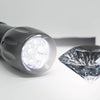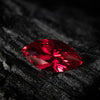
What is Internal Graining in Diamond Inclusions: Clarity Characteristics Explained
Internal graining in diamonds refers to the presence of lines or streaks within the gemstone, which occur naturally as the diamond forms beneath the Earth's surface. These lines can manifest as faint white marks that might resemble scratches or streaks but are in fact intrinsic to the diamond's structure. As a result of the extreme pressure and temperature conditions during formation, the diamond's crystal structure can be irregularly shaped, leading to the development of these distinctive features.
Inclusions like internal graining are important in evaluating a diamond's clarity, one of the four key characteristics considered when grading diamonds, along with carat weight, color, and cut. While inclusions are commonly perceived as flaws, they are also records of a diamond's geological history, offering a glimpse into the complex process of its creation. The clarity grade of the diamond can be affected by the amount and visibility of these inclusions.
We understand that discerning the intricate details of diamond inclusions requires a precise understanding of gemology. However, internal graining does not always negatively impact the diamond's appearance. In fact, each inclusion tells a unique story of the conditions under which the diamond crystallized, making each stone with internal graining distinct. Some may perceive these lines as detractions from the diamond's purity, while others may appreciate them as fascinating quirks that add character to the otherwise perfect crystalline structure.
Understanding Diamond Inclusions
In evaluating diamonds, inclusions are key features that we look at to determine the gem's quality. These characteristics are crucial for grading and provide insight into a diamond's history.
Definition of Inclusions
Inclusions refer to the internal imperfections naturally found within a diamond. They are typically formed during the diamond crystal's growth process and can take various shapes and sizes. The presence and visibility of these inclusions affect the clarity grade of a diamond, which is assessed by organizations like the Gemological Institute of America (GIA).
Common Types of Inclusions
Inclusions manifest in many forms, each affecting the diamond's appearance in different ways. Here are some of the most common types of diamond inclusions:
- Clouds: These are clusters of tiny pinpoints that can give the diamond a hazy appearance.
- Feathers: These are cracks within the diamond that resemble the structure of a feather.
- Crystals: These are other minerals embedded in the diamond.
- Needles: Long, thin inclusions that look like tiny needles.
- Pinpoints: Very small light or dark crystals that can appear individually or clustered together to form a cloud.
- Cavities: Small holes on the surface of a diamond, often created during the cutting process.
- Knots: These occur when a crystal reaches the surface of the diamond and is altered during polishing.
- Twinning Wisps: These are series of inclusions often resulting from irregular crystal growth.
- Indented Naturals: Part of the diamond’s original surface that dips below the polished diamond's surface.
- Bruises: Small areas of impact resulting in tiny cracks, usually caused by a hard blow.
Graining as a Type of Inclusion
Graining concerns the internal crystalline structure of the diamond. When the diamond experiences irregular growth, it can lead to the formation of graining. The GIA may note graining as part of their clarity grading process. These inclusions can appear as lines, which might be:
- White,
- Colored,
- Reflective.
The appearance of graining can vary; some are visible as faint lines, while others may make the diamond appear hazy. It's essential to consider graining in the overall evaluation of a diamond's clarity.
The Impact of Inclusions on Diamond Quality
Visibility of Inclusions 🔍
Visible inclusions affect diamond clarity and diminish brilliance.
Brilliance 💎
Diamonds with fewer inclusions exhibit enhanced sparkle and brilliance.
Durability 🛡️
Inclusions may weaken diamonds, reducing durability and increasing susceptibility to damage.
Value 💰
Diamonds with fewer inclusions are considered more valuable.
Impact on Certification 📜
Inclusions influence diamond grading, resulting in lower clarity grades for heavily included stones.
Considerations for Purchase 🤔
Evaluate inclusions when buying diamonds for satisfaction with the purchase.
In discussing the impact of inclusions on diamond quality, it's essential to understand how they affect clarity grading, as well as the size, location, and orientation of the inclusions themselves. We must also consider their implications on the overall durability of the diamond.
Clarity and Grading
Diamond clarity refers to the absence of inclusions and blemishes. Clarity grades range from 'Internally Flawless,' which indicates no inclusions or blemishes visible under 10x magnification, to diamonds with noticeable inclusions that may even be visible to the naked eye. The Gemological Institute of America (GIA) provides a detailed grading report, placing diamonds in categories such as VVS (Very, Very Slightly Included) for minor inclusions. These grades help determine the quality and value of a diamond.
Size, Location, and Orientation
Inclusions vary in size, location, and orientation, all of which impact a diamond's appearance and quality. Size is critical; larger inclusions affect transparency and can diminish brilliance. The location is just as important; inclusions near the center of a diamond are more visible and undesirable. In terms of orientation, inclusions that are aligned in such a way that they scatter light poorly can also reduce the stone’s transparency and sparkle.
- Size: A critical determinant of visibility under 10x magnification or to the naked eye.
- Location: Central inclusions impair appearance more than edge inclusions.
- Orientation: Can severely affect light reflection if unfavorably aligned.
Inclusions and Diamond Durability
While diamonds are known for their durability, inclusions can compromise this quality. Certain types of inclusions, such as feathers, are cracks within the diamond that can grow and lead to fractures if exposed to pressure or struck at certain angles. Understanding the type of inclusions, such as cloud inclusions which consist of tight groups of tiny crystals that can appear hazy, is crucial when evaluating a diamond's resistance to damage. Hence, the presence and nature of inclusions can make a substantial difference in the longevity and structural integrity of a diamond.
- Pressure: Diamonds with fewer inclusions typically withstand higher pressure.
- Crack/Fracture: Feathers and fractures risk further damage under strain or impact.
Specifics of Internal Graining

As we explore the characteristics of internal graining in diamonds, it's important to note that this inclusion can influence both the appearance and value of these gemstones.
Identifying Internal Graining
Internal graining is manifested as lines, waves, or curves within the diamond crystal. These patterns can range from whitish to transparent, often resembling faint stripes. During the polishing process, these internal features may become more noticeable if not handled correctly. In some cases, the graining can emit a faint glow or sheen when viewed under light and magnification. Identifying this form of inclusion requires a trained eye, typically using tools like a jeweler's loupe or microscope.
- Lines: parallel or intersecting
- Appearance: can be whitish, transparent
- Visibility: more apparent post-polishing
Formation of Graining in Diamonds
The formation of internal graining is linked to irregularities in crystal growth. It occurs under extreme pressure and temperatures that diamonds endure deep within the Earth. These conditions can cause distortions in the crystal lattice, forming unique patterns within each diamond crystal. The presence of internal graining serves as a testament to the natural forces at work during the diamond's creation.
- Crystal Growth: irregular, influenced by environmental conditions
- Pressure: extreme, contributes to graining formation
- Diamond Crystal: each has unique graining patterns due to natural formation processes
Graining and the Clarity Grade
Graining can affect a diamond's clarity grade. The Gemological Institute of America (GIA) takes the presence and visibility of internal graining into account when assigning a clarity grade. A diamond's grading report will mention internal graining if it impacts the overall quality. Significant graining that distorts or clouds the diamond may lower the clarity grade, while minimal or unobtrusive graining may have a negligible effect.
- Clarity Grade: assesses the overall quality, affected by graining
- GIA: considers graining in grading reports
- Effect on Clarity: dependent on the inclusiveness of the graining
By understanding internal graining, we gain insight into the geological story of each diamond and how it contributes to the gem's unique identity.
Understanding Grading Reports

When examining grading reports, our primary focus is on the accuracy and comprehensiveness of information related to diamond inclusions, such as internal graining. These reports are essential for determining the clarity and overall quality of the diamond.
Role of Gemological Laboratories
Gemological laboratories, such as the Gemological Institute of America (GIA) and the American Gem Society (AGS), serve a critical role in our industry. Their main task is to provide an unbiased grading of a diamond's characteristics. The laboratories' expert gemologists evaluate several aspects of each diamond, including the presence of inclusions and their impact on clarity. For us, the clarity grade assigned by these labs is a trusted indicator of the diamond's visual perfection.
Detailed Analysis of Inclusions in Reports
In grading reports, internal graining is a key clarity characteristic to be analyzed. It refers to lines or waves seen within the diamond, a reflection of its internal structure. These may appear whitish, colored, or reflective, and can sometimes affect transparency. The GIA's Diamond Grading Report, for example, will often include a diagram with symbols illustrating the position and nature of internal graining within the diamond. By thoroughly detailing each inclusion, including internal graining, the report conveys the precise reasons for a diamond's clarity grade.
Reading a Diamond Grading Report
When we read a diamond grading report, we're looking for several crucial pieces of information regarding clarity:
- Clarity Grade: The overall clarity classification of the diamond.
- Clarity Characteristics: Specifics about the inclusions and blemishes, including internal graining.
- Diagram: A visual representation of the inclusions within the diamond.
Using the report, we skillfully determine the impact of internal graining on the diamond's clarity, thus informing our choice or appraisal of the gemstone. It's essential to understand that these inclusions, as documented by gemological laboratories, define the uniqueness and authenticity of a diamond.
Diamond Clarity and Value

Diamond clarity is a critical factor that significantly influences a diamond's value and overall appearance. We will explore how various clarity characteristics affect price and guide you in selecting an appropriate diamond for your needs.
Factors Determining Diamond Value
The value of a diamond is primarily determined by its quality, which is assessed by the four Cs: Cut, Color, Clarity, and Carat weight. Each of these characteristics plays a vital role:
- Cut: The quality of the cut determines how well the diamond interacts with light, contributing to its brilliance.
- Color: A diamond's color grade affects its value; the more colorless, the more valuable.
- Clarity: Inclusions and blemishes, evaluated under 10x magnification, define the clarity grade.
- Carat Weight: Larger diamonds are rarer and, thus, more valuable, given that other quality factors are constant.
Clarity's Effect on Price
Clarity grades range from Flawless (FL) to Included (I), with several grades in between, such as Very, Very Slightly Included (VVS) and Very Slightly Included (VS). Diamonds with higher clarity grades are more valued due to their rarity and more transparent appearance. For instance, a 1-carat diamond with a VS2 clarity grade can have a price range between $5.9k to $8.2k. High clarity diamonds command higher prices due to their scarcity and aesthetic appeal.
Selecting an Eye-Clean Diamond
An "eye-clean" diamond is one that has no inclusions visible to the naked eye, typically without magnification. When selecting a diamond, our goal is often to find one that appears perfect to the unaided eye. This can often be achieved with diamonds graded as SI1 or better, which tend to be eye-clean, although this can vary depending on the size and location of the inclusions. Choosing an eye-clean diamond allows for potentially significant cost savings while maintaining an impeccable appearance.
The Aesthetic Aspects of Inclusions

In discussing the aesthetic impact of inclusions in diamonds, we must address how they contribute to each gem's unique appearance, the role of visibility in transparency, and the effect on brilliance and light performance.
Inclusions Contributing to Unique Beauty
Inclusions within diamonds, such as internal graining, can be seen as fingerprints of nature that imbue each stone with a unique character. These features often manifest as lines or waves within the diamond, creating distinct patterns that contribute to the stone's beauty. While some may view inclusions as imperfections, we recognize that they can add individuality to a diamond, much like brush strokes in a painting.
- Patterns: Varied, ranging from faint lines to waves
- Color: Can range from whitish to reflective nuances
Visible Inclusions and Transparency
The visibility of inclusions affects a diamond's transparency. Diamonds with inclusions that are less visible to the naked eye are often considered more desirable for their transparent quality. However, it is the interplay of these inclusions with the stone's clarity characteristics that creates a delicate balance, affecting the overall appearance.
- Clarity Characteristics
- Transparent: Inclusions barely noticeable
- Semi-transparent: Visible inclusions that may affect perception
Brilliance and Light Performance
The cut of a diamond directly influences how light travels through it, impacting its brilliance. Inclusions can affect a diamond's light performance, but not all inclusions necessarily detract from a diamond's sparkle. Some might even be positioned in a way that enhances the play of light within the stone.
- Brilliance: Evaluated by how inclusions interact with light
- Cut: Precision is key in shaping a diamond's response to light
Also Read
Frequently Asked Questions
In our focus on internal graining, we provide insights into its influence on facets of diamond evaluation, such as clarity grade and value, detection methods, variations, and comparisons with other inclusions.
How does internal graining affect a diamond's clarity grade?
Internal graining can affect a diamond's clarity grade as it is a type of inclusion. These grain lines can be seen under magnification and may impact the clarity rating depending on their visibility, color, and location within the stone.
Can internal graining in diamonds be detected without magnification?
Typically, internal graining requires magnification to detect. Some pronounced graining might be visible without magnification in larger diamonds or those with fewer inclusions, but this is not common.
What impact does internal graining have on the overall value of a diamond?
The presence of internal graining can lower a diamond's value if it affects the stone's clarity and overall appearance significantly. However, subtle graining that does not impact the diamond's brilliance may have less effect on its value.
Are there different types of internal graining in diamonds?
Yes, there are different types of internal graining, including lines, waves, or curves that may appear white, colored, or transparent. Each pattern is unique to the individual diamond, much like a fingerprint.
How do internal inclusions differ from surface graining in diamonds?
Internal graining refers to inclusions within the diamond, whereas surface graining pertains to irregularities on the diamond's surface. Both can stem from stress during the diamond's formation but are located in different areas of the stone.
What inclusions should be avoided when selecting a high-quality diamond?
When selecting a high-quality diamond, it's advisable to avoid inclusions that are visible to the naked eye, especially those that threaten the stone's structure, such as large feathers or cracks, or those that significantly impair its brilliance like large black crystals or dense clouds.
Checkout some of our top collections:
Leave a comment
Please note, comments must be approved before they are published.










